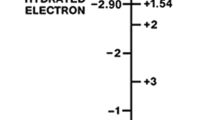Abstract
The addition of a drug to a system which contains an active transport mechanism may produce a large number of effects on both the active transport mechanism and the permeability of the system. A general model of such a system is presented, and various possible results of the drug's addition are discussed. Methods of experimentally separating these effects on the active transport mechanism and the permeabilities of the system are then listed and analyzed.
Similar content being viewed by others
Literature
Bowyer, F. 1957. “The Kinetics of the Penetration of Nonelectrolytes into the Mammalian Erythrocyte.”Int. Rev. Cytol.,6, 469–511.
— and W. F. Widdas. 1957. “The Importance of the Reaction at Both Interfaces in Facilitated Transfer.”Jour. Physiol.,136, 13–14P.
Brodie, B. B. and C. A. M. Hogben. 1957. “Some Physico-chemical Factors in Drug Action.”Jour. Pharm. Pharmacol.,9, 345–380.
Christensen, H. N. 1959. “Active Transport, with Special Reference to the Amino Acids.”Persp. in Biol. Med.,2, 228–242.
— 1960. “Reactive Sites and Biological Transport Especially of Amino Acids.”Adv. in Prot. Chem.,15, 239–314.
Danielli, J. F. 1954. “The Present Position in the Field of Facilitated Diffusion and Selective Active Transport.”Colston Papers,7, 1–14.
Frankenhaeuser, B. and A. L. Hodgkin. 1956. “The After-Effects of Impulses in the Giant Nerve Fibres of Loligo.”Jour. Physiol.,131, 341–376.
Glynn, I. M. 1956. “Sodium and Potassium Movements in Human Red Cells.” —Ibid.,134, 278–310.
— 1957. “The Action of Cardiac Glycosides on Sodium and Potassium Movements in Human Red Cells.” —Ibid.,136, 148–173.
Goldman, D. E. 1943. “Potential, Impedance, and Rectification in Membranes.”Jour. Gen. Physiol.,27, 37–60.
Goldman, D. E. 1959. “Analog Computer Solution of Ion Flux Equations.”Abstracts of the Biophysical Society.
Harris, E. J. 1956.Transport and Accumulation in Biological Systems. New York: Academic Press, Inc.
Heinz, E. and H. A. Mariani. 1957. “Concentration Work and Energy Dissipation in Active Transport of Glycine into Carcinoma Cells.”Jour. Biol. Chem., 228, 97–111.
— and P. M. Walsh. 1958. “Exchange Diffusion, Transport, and Intracellular Level of Amino Acids in Ehrlich Carcinoma Cells.”Jour. Biol. Chem.,233, 1488–1493.
Hodgkin, A. L. 1957. “Ionic Movements and Electrical Activity in Giant Nerve Fibres.”Proc. Roy. Soc., B.,148, 1–37.
— and R. D. Keynes. 1955. “Active Transport of Cations in Giant Axons from Sepia and Loligo.”Jour. Physiol.,128, 28–60.
Jardetsky, O. 1957. “On the Distinction between the Effects of Agents on Active and Passive Transport of Ions.”Science,125, 931–932.
Kirschner, L. B. 1955. “On the Mechanism of Active Sodium Transport across the Frog Skin.”Jour. Cell. Comp. Physiol.,45, 61–88.
— 1959. “The Interaction between Sodium Outflux and the Sodium Transport System in the Frog Skin.” —Ibid.,53, 85–92.
Koefoed-Johnsen, V., and H. H. Ussing. 1958. “The Nature of the Frog Skin Potential.”Acta. Physiol. Scand.,42, 298–308.
Maizels, M., M. Remington, and R. Truscoe. 1958. “Metabolism and Sodium Transfer of Mouse Ascites Tumor Cells.”Jour. Physiol.,140, 80–93.
Mitchell, P. 1957. “A General Theory of Membrane Transport from Studies of Bacteria.”Nature,180, 134–136.
Patlak, C. S. 1956. “Contributions to the Theory of Active Transport.”Bull. Math. Biophysics,18, 271–315.
— 1957. “Contributions to the Theory of Active Transport: II The Gate Type Non-Carrier Mechanism and Generalizations Concerning Tracer Flow, Efficiency, and Measurement of Energy Expenditure.” —Ibid.,19, 209–235.
Rosenberg, T. and W. Wilbrandt. 1957. “Uphill Transport Induced by Counterflow.”Jour. Gen. Physiol.,41, 289–296.
Shanes, A. M. 1956. “Distinction between Effects on Metabolic Transport and Passive Transfer of Ions.”Science,124, 724–725.
— 1957. “Ionic Transfer in a Vertebrate Nerve.”Metabolic Aspects of Transport across Cell Membranes, ed. Q. R. Murphy, pp. 127–150. Madison: Univ. Wisconsin Press.
— 1958. “Electrochemical Aspects of Physiological and Pharmacological Action in Excitable Cells. Part I. The Resting Cell and Its Alteration by Extrinsic Factors.”Pharm. Rev.,10, 59–164.
Shaw, T. I. 1955. “Potassium Movements in Washed Erythrocytes.”Jour. Physiol.,129, 464–475.
Sutcliffe, J. F. 1956. “The Selective Absorption of Alkali Cations by Storage Tissues and Intact Barley Cells.”Potassium-Symposium 1956, pp. 1–11. Berne: International Potash Institute.
Tosteson, D. C. and J. Johnson. 1957. “The Coupling of Potassium Transport with Metabolism in Duck Red Cells: I. The Effect of Sodium Fluoride and Other Metabolic Inhibitors.”Jour. Cell. Comp. Physiol.,50, 169–183.
Ussing, H. H. 1949a. “Transport of Ions across Cellular Membranes.”Physiol. Rev.,29, 127–155.
— 1949b. “The Distinction by Means of Tracers between Active Transport and Diffusion. The Transfer of Iodide across the Isolated Frog Skin.”Acta Physiol. Scand.,19, 43–56.
Author information
Authors and Affiliations
Rights and permissions
About this article
Cite this article
Patlak, C.S. Contributions to the theory of active transport: III. The effect of drugs on active transport systems. Bulletin of Mathematical Biophysics 23, 173–195 (1961). https://doi.org/10.1007/BF02477471
Received:
Issue Date:
DOI: https://doi.org/10.1007/BF02477471




